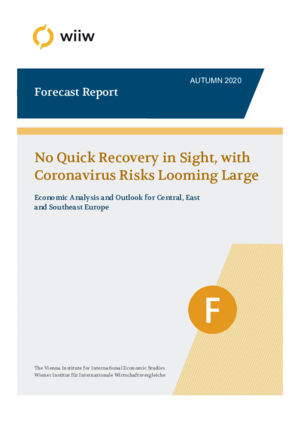No Quick Recovery in Sight, with Coronavirus Risks Looming Large
Vasily Astrov, Alexandra Bykova, Rumen Dobrinsky, Richard Grieveson, Doris Hanzl-Weiss, Philipp Heimberger, Gabor Hunya, Branimir Jovanović, Niko Korpar, Sebastian Leitner, Isilda Mara, Olga Pindyuk, Leon Podkaminer, Sandor Richter and Bernd Christoph Ströhm
wiiw Forecast Report No. Autumn 2020, November 2020
151 pages including 37 Tables, 46 Figures and 1 Box
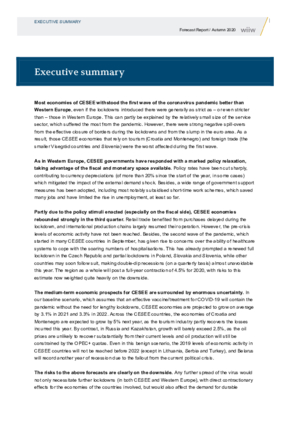
EXECUTIVE SUMMARY
free download
OVERVIEW 2018-2019 AND OUTLOOK 2020-2022
Premium Members only
Summary of key recent macroeconomic data for CESEE, and overview of new wiiw forecasts for 2020-2022 (Excel file)
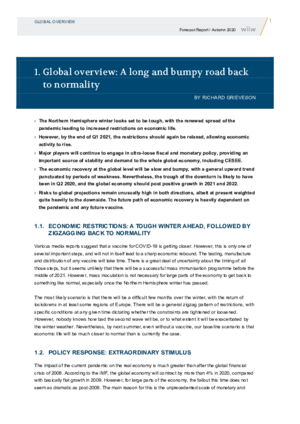
1. Global overview: A long and bumpy road back to normality
by Richard Grieveson
A renewed spread of the pandemic will lead to increased restrictions on economic life over the winter, but by the end of Q1 2021 restrictions should again be lifted, allowing economy activity to rise. Major players will continue to engage in ultra-loose fiscal and monetary policy, providing an important source of stability and demand. The economic recovery will be bumpy, with a general upward trend punctuated by period of weakness. Risks to global projections remain unusually high in both directions.
free download
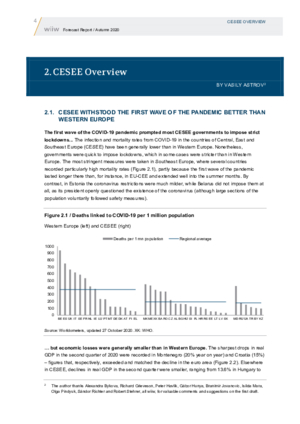
2. CESEE Overview
by Vasily Astrov, Philipp Heimberger and Sebastian Leitner
The recovery of CESEE economies in 2021-2022 will be sluggish and will depend on success in containing the pandemic without resort to lengthy lockdowns, as well as on the continuation of government support measures.
free download
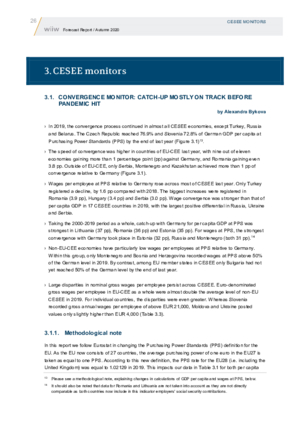
3.1 Convergence Monitor
by Alexandra Bykova
In 2019, the convergence process continued in almost all CESEE economies, except Turkey, Russia and Belarus; the Czech Republic and Slovenia remained top performers.
free download
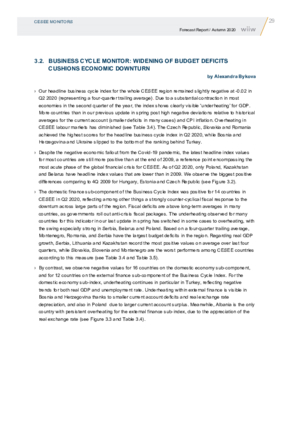
3.2 Business cycle monitor: Widening of budget deficits cushions economic downturn
by Alexandra Bykova
Despite the negative economic fallout from the pandemic, the business cycle index continues to suggest a more positive picture than after the 2009 global financial crisis. The domestic finance sub-component was positive for 14 countries in CESEE in Q2 2020, reflecting a strongly counter-cyclical fiscal response to the downturn across large parts of the region.
free download
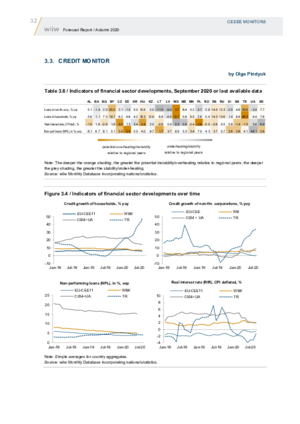
3.3 Credit monitor
by Olga Pindyuk
Credit growth slowed in large parts of the region during 2020, but the lending boom continued in Turkey.
free download
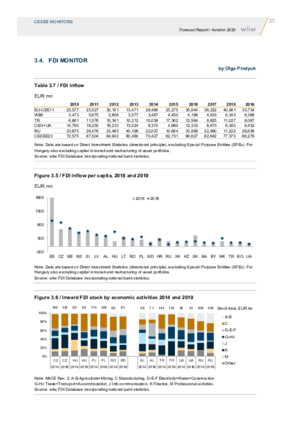
3.4 FDI monitor
by Olga Pindyuk
The most recent data show a rise in FDI inflows into CESEE, but the pandemic and its fallout could alter this trend in the coming years.
free download
You can also download separate country reports of this report
| No. | Title | Author | |
|---|---|---|---|
| 1 | ALBANIA: Light at the end of the tunnel, but still far off | Isilda Mara | Free Download |
| 2 | BELARUS: Popular revolt with uncertain prospects | Rumen Dobrinsky | Free Download |
| 3 | BOSNIA AND HERZEGOVINA: Limited policy options restrict pandemic response | Bernd Christoph Ströhm | Free Download |
| 4 | BULGARIA: Economy heading towards a slow recovery amidst continuing political unrest | Rumen Dobrinsky | Free Download |
| 5 | CROATIA: In the eye of the storm | Bernd Christoph Ströhm | Free Download |
| 6 | CZECH REPUBLIC: No V-shaped recovery in sight | Leon Podkaminer | Free Download |
| 7 | ESTONIA: Government uses fiscal space to support a bounce-back | Sebastian Leitner | Free Download |
| 8 | HUNGARY: Next Generation EU funds crucial to avoid delayed recovery | Sandor Richter | Free Download |
| 9 | KAZAKHSTAN: Fiscal policy to the rescue | Alexandra Bykova | Free Download |
| 10 | KOSOVO: Rising remittances limit the extent of economic decline | Isilda Mara | Free Download |
| 11 | LATVIA: After the slump, heading for a well-shaped recovery | Sebastian Leitner | Free Download |
| 12 | LITHUANIA: Rather a dip than an economic crisis | Sebastian Leitner | Free Download |
| 13 | MOLDOVA: Dependent on aid from both East and West | Gabor Hunya | Free Download |
| 14 | MONTENEGRO: Tourism decline drives major slump in economic growth | Bernd Christoph Ströhm | Free Download |
| 15 | NORTH MACEDONIA: Pandemic mishandling and inadequate fiscal support take toll on the economy | Branimir Jovanović | Free Download |
| 16 | POLAND: This time not quite a success story | Leon Podkaminer | Free Download |
| 17 | ROMANIA: Getting away with large fiscal imbalances | Gabor Hunya | Free Download |
| 18 | RUSSIA: Economic losses manageable so far, but clouds on the horizon | Vasily Astrov | Free Download |
| 19 | SERBIA: Expansionary fiscal policy helping the economy weather the crisis | Branimir Jovanović | Free Download |
| 20 | SLOVAKIA: Second wave threatens recovery | Doris Hanzl-Weiss | Free Download |
| 21 | SLOVENIA: Weathering the storm better than expected, but will it last? | Niko Korpar | Free Download |
| 22 | TURKEY: Sailing close to the wind again | Richard Grieveson | Free Download |
| 23 | UKRAINE: Fragile recovery in the face of growing risks | Olga Pindyuk | Free Download |
Reference to wiiw databases: wiiw Annual Database, wiiw Monthly Database
Keywords: CESEE, economic forecast, Central and Eastern Europe, Southeast Europe, Western Balkans, EU, euro area, CIS, China, Japan, US, convergence, business cycle, coronavirus, Next Generation EU funds, private consumption, credit, investment, digitalisation, exports, FDI, labour markets, unemployment, short-time work schemes, exchange rates, monetary policy, fiscal policy
JEL classification: E20, E21, E22, E24, E32, E5, E62, F21, F31, H60, I18, J20, J30, O47, O52, O57, P24, P27, P33, P52
Countries covered: Albania, Belarus, Bosnia and Herzegovina, Bulgaria, Central and East Europe, CESEE, China, CIS, Croatia, Czechia, Estonia, Euro Area, European Union, Hungary, Japan, Kazakhstan, Kosovo, Latvia, Lithuania, Moldova, Montenegro, New EU Member States, North Macedonia, Poland, Romania, Russia, Serbia, Slovakia, Slovenia, Southeast Europe, Turkey, Ukraine, US, Western Balkans
Research Areas: Macroeconomic Analysis and Policy, International Trade, Competitiveness and FDI
ISBN-13: 978-3-85209-070-2
Press Releases
Related Presentations
- Coronavirus lässt keine schnelle Erholung zu (press webinar presentation in German)
- No quick recovery in sight, coronavirus risks looming large (webinar presentation in English)
